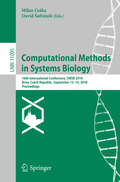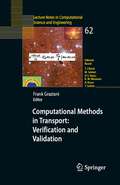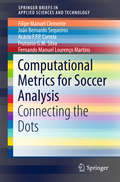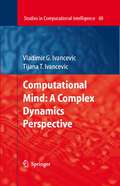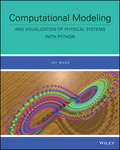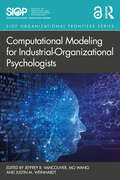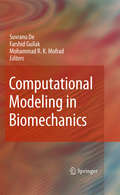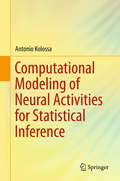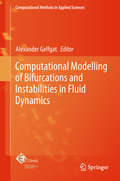- Table View
- List View
Computational Methods in Systems Biology: 17th International Conference, CMSB 2019, Trieste, Italy, September 18–20, 2019, Proceedings (Lecture Notes in Computer Science #11773)
by Luca Bortolussi Guido SanguinettiThis book constitutes the refereed proceedings of the 17th International Conference on Computational Methods in Systems Biology, CMSB 2019, held in Trieste, Italy, in September 2019.The 14 full papers, 7 tool papers and 11 posters were carefully reviewed and selected from 53 submissions. Topics of interest include formalisms for modeling biological processes; models and their biological applications; frameworks for model verification, validation, analysis, and simulation of biological systems; high-performance computational systems biology and parallel implementations; model inference from experimental data; model integration from biological databases; multi-scale modeling and analysis methods; computational approaches for synthetic biology; and case studies in systems and synthetic biology.
Computational Methods in Systems Biology: 16th International Conference, CMSB 2018, Brno, Czech Republic, September 12-14, 2018, Proceedings (Lecture Notes in Computer Science #11095)
by Milan Češka David ŠafránekThis book constitutes the refereed proceedings of the 16th International Conference on Computational Methods in Systems Biology, CMSB 2018, held in BRNO, Czech Republic, in September 2018. The 15 full and 7 short papers presented together with 5 invited talks were carefully reviewed and selected from 46 submissions. Topics of interest include formalisms for modeling biological processes; models and their biological applications; frameworks for model verification, validation, analysis, and simulation of biological systems; high-performance computational systems biology; parameter and model inference from experimental data; automated parameter and model synthesis; model integration and biological databases; multi-scale modeling and analysis methods; design, analysis, and verification methods for synthetic biology; methods for biomolecular computing and engineered molecular devices.Chapters 3, 9 and 10 are available open access under a Creative Commons Attribution 4.0 International License via link.springer.com.
Computational Methods in Systems Biology: First International Workshop, CMSB 2003, Roverto, Italy, February 24–26, 2003 (Lecture Notes in Computer Science #2602)
by Corrado PriamiComputational Methods in Transport: Granlibakken 2004 (Lecture Notes in Computational Science and Engineering #48)
by Frank GrazianiThereexistawiderangeofapplicationswhereasigni?cantfractionofthe- mentum and energy present in a physical problem is carried by the transport of particles. Depending on the speci?capplication, the particles involved may be photons, neutrons, neutrinos, or charged particles. Regardless of which phenomena is being described, at the heart of each application is the fact that a Boltzmann like transport equation has to be solved. The complexity, and hence expense, involved in solving the transport problem can be understood by realizing that the general solution to the 3D Boltzmann transport equation is in fact really seven dimensional: 3 spatial coordinates, 2 angles, 1 time, and 1 for speed or energy. Low-order appro- mations to the transport equation are frequently used due in part to physical justi?cation but many in cases, simply because a solution to the full tra- port problem is too computationally expensive. An example is the di?usion equation, which e?ectively drops the two angles in phase space by assuming that a linear representation in angle is adequate. Another approximation is the grey approximation, which drops the energy variable by averaging over it. If the grey approximation is applied to the di?usion equation, the expense of solving what amounts to the simplest possible description of transport is roughly equal to the cost of implicit computational ?uid dynamics. It is clear therefore, that for those application areas needing some form of transport, fast, accurate and robust transport algorithms can lead to an increase in overall code performance and a decrease in time to solution.
Computational Methods in Transport: Verification and Validation (Lecture Notes in Computational Science and Engineering #62)
by Frank GrazianiThe focus of this book deals with a cross cutting issue affecting all transport disciplines, whether it be photon, neutron, charged particle or neutrino transport. That is, verification and validation. In this book, we learn what the astrophysicist, atmospheric scientist, mathematician or nuclear engineer do to assess the accuracy of their code. What convergence studies, what error analysis, what problems do each field use to ascertain the accuracy of their transport simulations.
Computational Methods, Seismic Protection, Hybrid Testing and Resilience in Earthquake Engineering: A Tribute to the Research Contributions of Prof. Andrei Reinhorn (Geotechnical, Geological and Earthquake Engineering #33)
by Gian Paolo Cimellaro Satish Nagarajaiah Sashi K. KunnathThe book is a tribute to the research contribution of Professor Andrei Reinhorn in the field of earthquake engineering. It covers all the aspects connected to earthquake engineering starting from computational methods, hybrid testing and control, resilience and seismic protection which have been the main research topics in the field of earthquake engineering in the last 30 years. These were all investigated by Prof. Reinhorn throughout his career. The book provides the most recent advancements in these four different fields, including contributions coming from six different countries giving an international outlook to the topics.
Computational Methods to Examine Team Communication: When and How to Change the Conversation (Computational Social Sciences)
by Sara McComb Deanna KennedyThe primary focus of this book is an examination of longitudinal team communication and its impact on team performance. This theoretically-grounded, holistic examination of team communication includes cross-condition comparisons of team (i.e., distributed/in person, unrestricted/time pressured, two performance episodes) and employs multiple quantitative methodological approaches to examine the phenomena of interest. This book simultaneously provides practical content for researchers and practitioners in the social sciences and humanities. Included are step-by-step instructions for the methodologies employed, and distillations of findings via Managerial Minutes that highlight best practices and/or examples to help enhance team communication in practice.
Computational Methods to Study the Structure and Dynamics of Biomolecules and Biomolecular Processes: From Bioinformatics to Molecular Quantum Mechanics (Springer Series on Bio- and Neurosystems #8)
by Adam LiwoThis book provides a comprehensive overview of modern computer-based techniques for analyzing the structure, properties and dynamics of biomolecules and biomolecular processes. It is organized in four main parts; the first one deals with methodology of molecular simulations; the second one with applications of molecular simulations; the third one introduces bioinformatics methods and the use of experimental information in molecular simulations; the last part reports on selected applications of molecular quantum mechanics. This second edition has been thoroughly revised and updated to include the latest progresses made in the respective field of research.
Computational Metrics for Soccer Analysis: Connecting the dots (SpringerBriefs in Applied Sciences and Technology)
by Filipe Manuel Clemente João Bernardo Sequeiros Acácio F.P.P. Correia Frutuoso G. Silva Fernando Manuel MartinsThis book provides an account of the use of computational tactical metrics in improving sports analysis, in particular the use of Global Positioning System (GPS) data in soccer. As well as offering a practical perspective on collective behavioural analysis, it introduces the computational metrics available in the literature that allow readers to identify collective behaviour and patterns of play in team sports. These metrics only require the bio-dimensional geo-referencing information from GPS or video-tracking systems to provide qualitative and quantitative information about the tactical behaviour of players and the inter-relationships between teammates and their opponents. Exercises, experimental cases and algorithms enable readers to fully comprehend how to compute these metrics, as well as introducing them to the ultimate performance analysis tool, which is the basis to run them on. The script to compute the metrics is presented in Python. The book is a valuable resource for professional analysts as well students and researchers in the field of sports analysis wanting to optimise the use of GPS trackers in soccer.
Computational Mind: A Complex Dynamics Perspective (Studies in Computational Intelligence #60)
by Vladimir G. Ivancevic Tijana T. IvancevicThis is a graduate–level monographic textbook in the field of Computational Intelligence. It presents a modern dynamical theory of the computational mind, combining cognitive psychology, artificial and computational intelligence, and chaos theory with quantum consciousness and computation. The book introduces to human and computational mind, comparing and contrasting main themes of cognitive psychology, artificial and computational intelligence.
Computational Modeling and Problem Solving in the Networked World: Interfaces in Computer Science and Operations Research (Operations Research/Computer Science Interfaces Series #21)
by Hemant K. Bhargava Nong YeThis book is a compilation of a selected subset of research articles presented at the Eighth INFORMS Computing Society Conference, held in Chandler, Arizona, from January 8 to 10, 2003. The articles in this book represent the diversity and depth of the interface between ORiMS (operations research and the management sciences) and CS/AI (computer science and artificial intelligence ). This volume starts with two papers that represent the reflective and integrative thinking that is critical to any scientific discipline. These two articles present philosophical perspectives on computation, covering a variety of traditional and newer methods for modeling, solving, and explaining mathematical models. The next set includes articles that study machine learning and computational heuristics, and is followed by articles that address issues in performance testing of solution algorithms and heuristics. These two sets of papers demonstrate the richness of thought that takes place at the ORiMS and CSI AI interface. The final set of articles demonstrates the usefulness of these and other methods at the interface towards solving problems in the real world, covering e-commerce, workflow, electronic negotiation, music, parallel computation, and telecommunications. The articles in this collection represent the results of cross-fertilization between ORiMS and CSI AI, making possible advances that could have not been achieved in isolation. The continuing aim ofthe INFORMS Computing Society and this research conference is to invigorate and further develop this interface.
Computational Modeling and Visualization of Physical Systems with Python
by Jay WangComputational Modeling, by Jay Wang introduces computational modeling and visualization of physical systems that are commonly found in physics and related areas. The authors begin with a framework that integrates model building, algorithm development, and data visualization for problem solving via scientific computing. Through carefully selected problems, methods, and projects, the reader is guided to learning and discovery by actively doing rather than just knowing physics.
Computational Modeling for Industrial-Organizational Psychologists (SIOP Organizational Frontiers Series)
by Jeffrey B. Vancouver Mo Wang Justin M. WeinhardtThis collection provides a primer to the process and promise of computational modeling for industrial-organizational psychologists. With contributions by global experts in the field, the book is designed to expand readers’ appreciation for computational modeling via chapters focused on key modeling achievements in domains relevant to industrial-organizational psychology, including decision making in organizations, diversity and inclusion, learning and training, leadership, and teams.To move the use of computational modeling forward, the book includes specific how-to-chapters on two of the most commonly used modeling approaches: agent-based modeling and system dynamics modeling. It also gives guidance on how to evaluate these models qualitatively and quantitatively, and offers advice on how to read, review, and publish papers with computational models. The authors provide an extensive description of the myriad of values computational modeling can bring to the field, highlighting how they offer a more transparent, precise way to represent theories and can be simulated to offer a test of the internal consistency of a theory and allow for predictions. This is accompanied by an overview of the history of computational modeling as it relates to I-O psychology. Throughout, the authors reflect on computational modeling’s journey, looking back to its history as they imagine its future in I-O psychology.Each contribution demonstrates the value and opportunities computational modeling can provide the individual researcher, research teams, and fields of I-O psychology and management. This volume is an ideal resource for anyone interested in computational modeling, from scholarly consumers to computational model creators.Chapter 1 of this book is freely available as a downloadable Open Access PDF at http://www.taylorfrancis.com under a Creative Commons Attribution-Non Commercial-No Derivatives (CC-BY-NC-ND) 4.0 license.
Computational Modeling for Industrial-Organizational Psychologists (SIOP Organizational Frontiers Series)
This collection provides a primer to the process and promise of computational modeling for industrial-organizational psychologists. With contributions by global experts in the field, the book is designed to expand readers’ appreciation for computational modeling via chapters focused on key modeling achievements in domains relevant to industrial-organizational psychology, including decision making in organizations, diversity and inclusion, learning and training, leadership, and teams.To move the use of computational modeling forward, the book includes specific how-to-chapters on two of the most commonly used modeling approaches: agent-based modeling and system dynamics modeling. It also gives guidance on how to evaluate these models qualitatively and quantitatively, and offers advice on how to read, review, and publish papers with computational models. The authors provide an extensive description of the myriad of values computational modeling can bring to the field, highlighting how they offer a more transparent, precise way to represent theories and can be simulated to offer a test of the internal consistency of a theory and allow for predictions. This is accompanied by an overview of the history of computational modeling as it relates to I-O psychology. Throughout, the authors reflect on computational modeling’s journey, looking back to its history as they imagine its future in I-O psychology.Each contribution demonstrates the value and opportunities computational modeling can provide the individual researcher, research teams, and fields of I-O psychology and management. This volume is an ideal resource for anyone interested in computational modeling, from scholarly consumers to computational model creators.Chapter 1 of this book is freely available as a downloadable Open Access PDF at http://www.taylorfrancis.com under a Creative Commons Attribution-Non Commercial-No Derivatives (CC-BY-NC-ND) 4.0 license.
Computational Modeling in Biological Fluid Dynamics (The IMA Volumes in Mathematics and its Applications #124)
by Lisa J. Fauci Shay GueronThis IMA Volume in Mathematics and its Applications COMPUTATIONAL MODELING IN BIOLOGICAL FLUID DYNAMICS is based on the proceedings of a very successful workshop with the same title. The workshop was an integral part of the September 1998 to June 1999 IMA program on "MATHEMATICS IN BIOLOGY." I would like to thank the organizing committee: Lisa J. Fauci of Tulane University and Shay Gueron of Technion - Israel Institute of Technology for their excellent work as organizers of the meeting and for editing the proceedings. I also take this opportunity to thank the National Science Founda tion (NSF), whose financial support of the IMA made the Mathematics in Biology program possible. Willard Miller, Jr., Professor and Director Institute for Mathematics and its Applications University of Minnesota 400 Lind Hall, 207 Church St. SE Minneapolis, MN 55455-0436 612-624-6066, FAX 612-626-7370 miller@ima.umn.edu World Wide Web: http://www.ima.umn.edu v PREFACE A unifying theme in biological fluid dynamics is the interaction of moving, elastic boundaries with a surrounding fluid. A complex dynami cal system describes the motion of red blood cells through the circulatory system, the movement of spermatazoa in the reproductive tract, cilia of microorganisms, or a heart pumping blood. The revolution in computa tional technology has allowed tremendous progress in the study of these previously intractable fluid-structure interaction problems.
Computational Modeling in Biomechanics
by Suvranu De Farshid Guilak Mohammad R.K. MofradAvailability of advanced computational technology has fundamentally altered the investigative paradigm in the field of biomechanics. Armed with sophisticated computational tools, researchers are seeking answers to fundamental questions by exploring complex biomechanical phenomena at the molecular, cellular, tissue and organ levels. The computational armamentarium includes such diverse tools as the ab initio quantum mechanical and molecular dynamics methods at the atomistic scales and the finite element, boundary element, meshfree as well as immersed boundary and lattice-Boltzmann methods at the continuum scales. Multiscale methods that link various scales are also being developed. While most applications require forward analysis, e.g., finding deformations and stresses as a result of loading, others involve determination of constitutive parameters based on tissue imaging and inverse analysis. This book provides a glimpse of the diverse and important roles that modern computational technology is playing in various areas of biomechanics including biofluids and mass transfer, cardiovascular mechanics, musculoskeletal mechanics, soft tissue mechanics, and biomolecular mechanics.
Computational Modeling of Biological Systems: From Molecules to Pathways (Biological and Medical Physics, Biomedical Engineering)
by Nikolay V DokholyanComputational modeling is emerging as a powerful new approach to study and manipulate biological systems. Multiple methods have been developed to model, visualize, and rationally alter systems at various length scales, starting from molecular modeling and design at atomic resolution to cellular pathways modeling and analysis. Higher time and length scale processes, such as molecular evolution, have also greatly benefited from new breeds of computational approaches. This book provides an overview of the established computational methods used for modeling biologically and medically relevant systems.
Computational Modeling of Neural Activities for Statistical Inference
by Antonio KolossaThis authored monograph supplies empirical evidence for the Bayesian brain hypothesis by modeling event-related potentials (ERP) of the human electroencephalogram (EEG) during successive trials in cognitive tasks. The employed observer models are useful to compute probability distributions over observable events and hidden states, depending on which are present in the respective tasks. Bayesian model selection is then used to choose the model which best explains the ERP amplitude fluctuations. Thus, this book constitutes a decisive step towards a better understanding of the neural coding and computing of probabilities following Bayesian rules. The target audience primarily comprises research experts in the field of computational neurosciences, but the book may also be beneficial for graduate students who want to specialize in this field.
Computational Modeling of Objects Presented in Images: Fundamentals, Methods and Applications (Lecture Notes in Computational Vision and Biomechanics #15)
by Paolo Giamberardino Daniela Iacoviello Renato Natal Jorge João Manuel R. S. TavaresThis book contains extended versions of selected papers from the 3rd edition of the International Symposium CompIMAGE.These contributions include cover methods of signal and image processing and analysis to tackle problems found in medicine, material science, surveillance, biometric, robotics, defence, satellite data, traffic analysis and architecture, image segmentation, 2D and 3D reconstruction, data acquisition, interpolation and registration, data visualization, motion and deformation analysis and 3D vision.
Computational Modelling of Bifurcations and Instabilities in Fluid Dynamics (Computational Methods in Applied Sciences #50)
by Alexander GelfgatInstabilities of fluid flows and the associated transitions between different possible flow states provide a fascinating set of problems that have attracted researchers for over a hundred years. This book addresses state-of-the-art developments in numerical techniques for computational modelling of fluid instabilities and related bifurcation structures, as well as providing comprehensive reviews of recently solved challenging problems in the field.
Computational Models for CO2 Geo-sequestration & Compressed Air Energy Storage
by Rafid Al-Khoury Jochen BundschuhA comprehensive mathematical and computational modeling of CO2 Geosequestration and Compressed Air Energy StorageEnergy and environment are two interrelated issues of great concern to modern civilization. As the world population will soon reach eight billion, the demand for energy will dramatically increase, intensifying the use of fossil fuels. Ut
Computational Models For Turbulent Reacting Flows (Cambridge Series In Chemical Engineering Ser.)
by Arvind Varma Rodney O. FoxThis book presents the current state of the art in computational models for turbulent reacting flows, and analyzes carefully the strengths and weaknesses of the various techniques described. The focus is on formulation of practical models as opposed to numerical issues arising from their solution. A theoretical framework based on the one-point, one-time joint probability density function (PDF) is developed. It is shown that all commonly employed models for turbulent reacting flows can be formulated in terms of the joint PDF of the chemical species and enthalpy. Models based on direct closures for the chemical source term as well as transported PDF methods are covered in detail. An introduction to the theory of turbulent and turbulent scalar transport is provided for completeness. The book is aimed at chemical, mechanical, and aerospace engineers in academia and industry, as well as developers of computational fluid dynamics codes for reacting flows.
Computational Models of Rhythm and Meter
by Georg BoennThis book presents the latest computational models of rhythm and meter that are based on number theory, combinatorics and pattern matching. Two computational models of rhythm and meter are evaluated: The first one explores a relatively new field in Mathematics, namely Combinatorics on Words, specifically Christoffel Words and the Burrows-Wheeler Transform, together with integer partitions. The second model uses filtered Farey Sequences in combination with specific weights that are assigned to inter-onset ratios. This work is assessed within the context of the current state of the art of tempo tracking and computational music transcription. Furthermore, the author discusses various representations of musical rhythm, which lead to the development of a new shorthand notation that will be useful for musicologists and composers. Computational Models of Rhythm and Meter also contains numerous investigations into the timing structures of human rhythm and metre perception carried out within the last decade. Our solution to the transcription problem has been tested using a wide range of musical styles, and in particular using two recordings of J.S. Bach's Goldberg Variations by Glenn Gould. The technology is capable of modelling musical rhythm and meter by using Farey Sequences, and by detecting duration classes in a windowed analysis, which also detects the underlying tempo. The outcomes represent human performances of music as accurate as possible within Western score notation.
Computational Models of Speech Pattern Processing (NATO ASI Subseries F: #169)
by Keith PontingProceedings of the NATO Advanced Study Institute on Computational Models of Speech Pattern Processing, held in St. Helier, Jersey, UK, July 7-18, 1997
Computational Molecular Dynamics: Proceeding of the 2nd International Symposium on Algorithms for Macromolecular Modelling, Berlin, May 21–24, 1997 (Lecture Notes in Computational Science and Engineering #4)
by Peter Deuflhard Jan Hermans Benedict Leimkuhler Alan E. Mark Sebastian Reich Robert D. SkeelOn May 21-24, 1997 the Second International Symposium on Algorithms for Macromolecular Modelling was held at the Konrad Zuse Zentrum in Berlin. The event brought together computational scientists in fields like biochemistry, biophysics, physical chemistry, or statistical physics and numerical analysts as well as computer scientists working on the advancement of algorithms, for a total of over 120 participants from 19 countries. In the course of the symposium, the speakers agreed to produce a representative volume that combines survey articles and original papers (all refereed) to give an impression of the present state of the art of Molecular Dynamics.The 29 articles of the book reflect the main topics of the Berlin meeting which were i) Conformational Dynamics, ii) Thermodynamic Modelling, iii) Advanced Time-Stepping Algorithms, iv) Quantum-Classical Simulations and Fast Force Field and v) Fast Force Field Evaluation.

